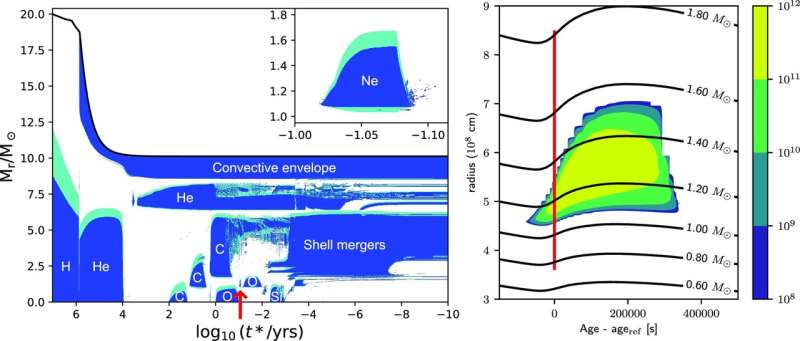This article has been reviewed according to Science X's editorial process and policies. Editors have highlighted the following attributes while ensuring the content's credibility:
fact-checked
peer-reviewed publication
trusted source
proofread
Simulations reveal 'unprecedented details' of a star's evolutionary phase

Scientists have conducted the first ever 3D simulation of a star's entire evolutionary phase thanks to new simulation technologies.
An international team of researchers led by Keele University have used the latest advances in computer processing and simulation technologies to study a "nuclear burning phase" of a star's evolution in unprecedented levels of detail and realism.
Advancing current models
Most of our scientific understanding of stars and their life cycles come from one-dimensional models, which are severely limited in their accuracy and the amount of detail they can provide. The complex processes inside stars also mean there are many uncertainties that can make these simulations unreliable.
But new advances in computer simulation technology have enabled the researchers to produce a 3D simulation of an entire stellar phase for the first time ever, continuously showing a portion of the star from the early development of this phase through to its complete exhaustion.
Their findings, published in the Monthly Notices of the Royal Astronomical Society, provide crucial answers to long-debated questions in stellar physics.
'The dawn of 3D stellar evolution'
Lead author Federico Rizzuti, a Ph.D. student from Keele University, said, "For this new publication, we have run 3D simulations of stellar interiors for long enough to see the evolution of one entire 'nuclear burning phase,' which has never been done before.
"This allowed us to study in detail how a nuclear burning phase develops and eventually dies, particularly the complex interaction between nuclear reactions and turbulence in the stellar layers, with a new degree of precision and realism.
"We have found that the nuclear reactions are really efficient during this phase, and soon they consume all the fuel, halting also the movement of elements across the star's different layers. We were also able to study what chemical elements were consumed and produced during this phase.
"This will give us new information on how stars live and die, and whether they produce supernova explosion, neutron stars and black holes when they die. Our work also shows that it is finally possible to simulate long portions of a star's life with 3D models, and we are sure that soon we will see more of these 3D stellar simulations: this is why we call it the 'dawn of 3D stellar evolution.'"
More information: F Rizzuti et al, 3D stellar evolution: hydrodynamic simulations of a complete burning phase in a massive star, Monthly Notices of the Royal Astronomical Society (2023). DOI: 10.1093/mnras/stad1572
Journal information: Monthly Notices of the Royal Astronomical Society
Provided by Keele University





















